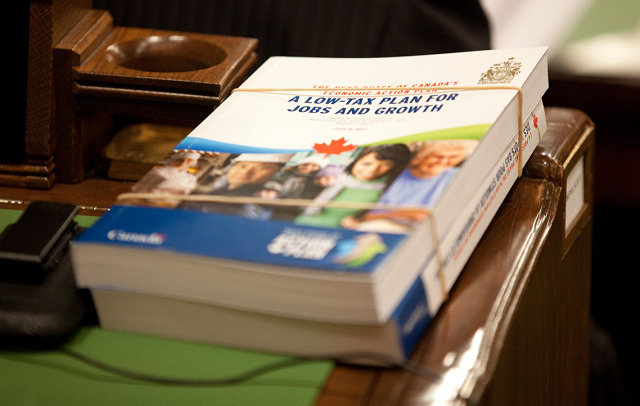The Minister of Finance on Tuesday announced the fall update to the country’s finances. There was a surprise in the works for Canadians: instead of the $3.8 billion surplus in 2015-16 from the 2013 Budget, Finance is now projecting a $6.7 billion surplus — or nearly twice as much money. In both cases, the published projections include a randomly selected subtraction $3 billion “risk adjustment,” meaning the published surpluses are projected at $0.8 billion (2013 Budget) and $3.7 billion (Fall Update).
So where did the surprise cash come from to balance the budget in time for the election? Stupendous economic growth, substantial new employment? Hardly.
In fact, the government is benefiting from a reduction in transfers to persons, particularly transfers to the elderly. It is also benefiting from lower than projected interest rates due to consistently low growth. Transfers to non-governmental organizations are also taking a hit.
Unfortunately, lacklustre growth is also taking its toll on the revenue side, particularly with personal income tax revenues being revised downward. However, other revenue categories are projected to remain relatively unchanged in 2015-16.
The decrease in departmental transfers to outside organizations as well as to seniors more than offsets the drop in personal income tax revenues. This overall dynamic will add to the surplus in 2015-16.
What is perhaps more interesting is the government’s additional changes to make very sure there is a surplus in time for 2015. On the one hand, extending the freeze on EI premiums continues a small stimulus measure for employers and employees, although in a relatively low impact multiplier. This works against the surplus.
What is substantially contributing to the surplus in 2015 is a new freeze in operational funding as well as a fire sale of assets. In the speech from the throne the government announced that it would continue its freeze of operational funding. In practice what this means is that, in an unco-ordinated way, individual departments will cut back services in order to meet inflationary needs. In other words, if you have the same amount of money each year and inflation increases costs, you can buy less and less every year with your constricted budget. This will mean more closures of veterans’ offices; increasingly long wait times to access EI, either due to lost employment or maternity; fewer inspectors for food and transport; etc.
What’s specifically new to the fall update is an asset fire sale. In the past, these have largely involved selling buildings the government occupies with an agreement to lease them back for a long period assuring sustained profits for new landlords, well above whatever they bought it for. This makes poor economic sense, particularly to finance election promises in 2015.
In short, the larger surplus in the fall update is due to asset sales and service cuts, which are only partially offset by a freeze in EI premiums. There is no financial management magic here, only fewer supports for Canadians and longer-term costs.
Oh yeah, and most of these service cuts and fire sales will pay for tax cuts for Canada’s wealthiest households… stay tuned.
Photo: photoswebpm/flickr




